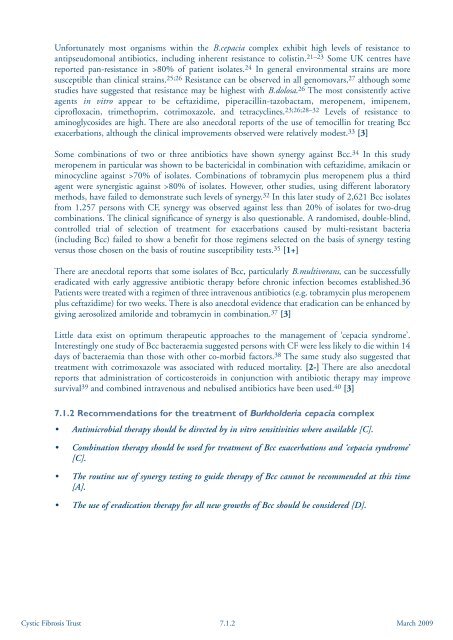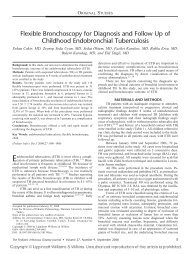Report of the UK Cystic Fibrosis Trust Antibiotic Working Group
Report of the UK Cystic Fibrosis Trust Antibiotic Working Group
Report of the UK Cystic Fibrosis Trust Antibiotic Working Group
Create successful ePaper yourself
Turn your PDF publications into a flip-book with our unique Google optimized e-Paper software.
Unfortunately most organisms within <strong>the</strong> B.cepacia complex exhibit high levels <strong>of</strong> resistance toantipseudomonal antibiotics, including inherent resistance to colistin. 21–23 Some <strong>UK</strong> centres havereported pan-resistance in >80% <strong>of</strong> patient isolates. 24 In general environmental strains are moresusceptible than clinical strains. 25;26 Resistance can be observed in all genomovars, 27 although somestudies have suggested that resistance may be highest with B.dolosa. 26 The most consistently activeagents in vitro appear to be ceftazidime, piperacillin-tazobactam, meropenem, imipenem,cipr<strong>of</strong>loxacin, trimethoprim, cotrimoxazole, and tetracyclines. 23;26;28–32 Levels <strong>of</strong> resistance toaminoglycosides are high. There are also anecdotal reports <strong>of</strong> <strong>the</strong> use <strong>of</strong> temocillin for treating Bccexacerbations, although <strong>the</strong> clinical improvements observed were relatively modest. 33 [3]Some combinations <strong>of</strong> two or three antibiotics have shown synergy against Bcc. 34 In this studymeropenem in particular was shown to be bactericidal in combination with ceftazidime, amikacin orminocycline against >70% <strong>of</strong> isolates. Combinations <strong>of</strong> tobramycin plus meropenem plus a thirdagent were synergistic against >80% <strong>of</strong> isolates. However, o<strong>the</strong>r studies, using different laboratorymethods, have failed to demonstrate such levels <strong>of</strong> synergy. 32 In this later study <strong>of</strong> 2,621 Bcc isolatesfrom 1,257 persons with CF, synergy was observed against less than 20% <strong>of</strong> isolates for two-drugcombinations. The clinical significance <strong>of</strong> synergy is also questionable. A randomised, double-blind,controlled trial <strong>of</strong> selection <strong>of</strong> treatment for exacerbations caused by multi-resistant bacteria(including Bcc) failed to show a benefit for those regimens selected on <strong>the</strong> basis <strong>of</strong> synergy testingversus those chosen on <strong>the</strong> basis <strong>of</strong> routine susceptibility tests. 35 [1+]There are anecdotal reports that some isolates <strong>of</strong> Bcc, particularly B.multivorans, can be successfullyeradicated with early aggressive antibiotic <strong>the</strong>rapy before chronic infection becomes established.36Patients were treated with a regimen <strong>of</strong> three intravenous antibiotics (e.g. tobramycin plus meropenemplus ceftazidime) for two weeks. There is also anecdotal evidence that eradication can be enhanced bygiving aerosolized amiloride and tobramycin in combination. 37 [3]Little data exist on optimum <strong>the</strong>rapeutic approaches to <strong>the</strong> management <strong>of</strong> ‘cepacia syndrome’.Interestingly one study <strong>of</strong> Bcc bacteraemia suggested persons with CF were less likely to die within 14days <strong>of</strong> bacteraemia than those with o<strong>the</strong>r co-morbid factors. 38 The same study also suggested thattreatment with cotrimoxazole was associated with reduced mortality. [2-] There are also anecdotalreports that administration <strong>of</strong> corticosteroids in conjunction with antibiotic <strong>the</strong>rapy may improvesurvival 39 and combined intravenous and nebulised antibiotics have been used. 40 [3]7.1.2 Recommendations for <strong>the</strong> treatment <strong>of</strong> Burkholderia cepacia complex• Antimicrobial <strong>the</strong>rapy should be directed by in vitro sensitivities where available [C].• Combination <strong>the</strong>rapy should be used for treatment <strong>of</strong> Bcc exacerbations and ‘cepacia syndrome’[C].• The routine use <strong>of</strong> synergy testing to guide <strong>the</strong>rapy <strong>of</strong> Bcc cannot be recommended at this time[A].• The use <strong>of</strong> eradication <strong>the</strong>rapy for all new growths <strong>of</strong> Bcc should be considered [D].<strong>Cystic</strong> <strong>Fibrosis</strong> <strong>Trust</strong> 7.1.2March 2009






